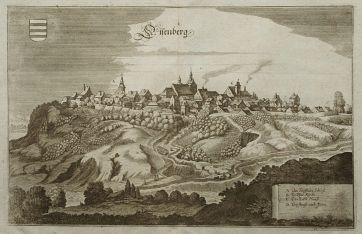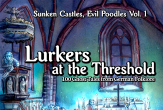The Ghostly Wedding in the Deserted Village of Scortowe

|
| Geographic Coordinates: 50° 58' 34.84" N, 11° 54' 35.26" E |
Once, there was an ancient village of the Wends in the Schortental valley near Eisenberg, but this was a long, long time ago. This village was named “Scortowe”. Many years ago, this village was abandoned and now nothing of it is visible any more. However, in earlier times it was frequently seen during certain blessed nights and during the right hour — in the middle of the Schortental valley, on a green, quiet forest meadow. But now no one can behold it any more, for it was released from the heavy curse which made it visible in holy nights in every tenth leap year.
Quite a few years ago, there was an honest, poor girl in Eisenberg who had arrived with Protestants emigrating from Salzburg and found a place to stay with compassionate locals. One evening, when it was already turning dark, she was sent out in order to fetch some feed for the livestock from the Schortental valley. As she was unafraid, she fearlessly proceeded through the rustling woods that were quiet in the evening, until she safely arrived in the meadow in the Schortental where she usually gathered the requested feed. But, instead of the meadow, she beheld an old village before her, which was unknown to her and whose name she did not know. Light shimmered out of its small, old-fashioned houses. Initially she was startled and frightened, but soon she gathered her courage and knocked carefully on the windows of the first, brightly lit house. She asked for directions as well as where she was, and, as she was rather hungry and thirsty, pleaded for a piece of bread and a bit of water to drink. An old man with a white beard and strange garb opened the window, and told the girl to enter. Nervously, she followed the invitation and entered the low chamber in which a merry group seemed to be celebrating a wedding. Demurely, she greeted them, and repeated her request. Upon hearing this, the old man who had invited her bade her to sit down and passed food and drink in strangely-formed bowls and cups to her. As far as she could see, everything in the entire chamber seemed to be like it was from an old, long-ago time: Bowls and cutlery, tables and chairs, everything was fantastically strange and unfamiliar. All the guests wore strange garb out of a long-lost time, with old-fashioned and baggy suits and dresses. The bride was costumed like a nun with a long, flowing veil and severe garb right out of a monastery. The groom, on the other hand, was wearing a luxurious tunic embroidered with gold and silver in the manner of a knight, a long, glittering rapier at his side, as well as a heavy, golden honor chain on his chest.
The old man sympathetically questioned the girl about her situation and circumstances, and, as soon as he had been convinced of her poverty and her good, honest heart, he spoke with the groom for a long time in a strange, unknown language. After that, the knight approached her with a visibly delighted countenance, and said: “My thanks, my child, that you have come here. Soon, we will attain eternal joy and peace.”
Then the wedding dances started, which were odd dances accompanied by strange, fantastic music which the girl had never danced to before. Only now and then there was a dance she was familiar with, and she always danced those with the handsome groom. Finally, a weird dance started that involved the most fantastic jumps and turns.
Then, suddenly, in the middle of the merry, carefree pirouettes it suddenly became calm and quiet. Twelve blows of the horn reverberated eerily through the night. Then there was silence once more, and everything vanished at once — the cheerful party of the guests, the merry musicians, the old, peculiar tables and cutlery, the whole strange village.
As the poor girl looked around in consternation, she once again stood alone in the dark night on the quiet forest meadow, and did not know what had happened to her. She quickly hurried home. There, she discovered a beret in her basket which she remembered being worn by the handsome groom. Within the beret, there were quite a few old, heavy gold and silver coins, as well as a rolled-up, yellowed sheet of parchment. The following was written on the parchment in gothic letters:
“In the year 1400, the knight Siegbert von Hainsburg abducted the noble maiden Elsbethe von Kunitzburg from the convent at Eisenberg. He married her at the home of a sympathetic serf belonging to the convent, and lived a happy and blessed life with her until his demise. However, after their death this was judged to be a major sin to their account, and they had to spend one hundred years of torment in purgatory. But then, after the convent had long been abandoned and the village of Scortowe had been razed in the Thirty Years War, they had to stage mock weddings in the same location. They were to repeat this in every tenth leap year on the day of the full moon while the Sun was located in the sign of Cancer, until a poor, but honest and fearless girl would visit them three hours before midnight and ask for something. Many years have passed since then, and thirty-three leap years have gone by, many people have seen the abandoned village, but no honest girl has dared to approach it alone during the blessed hour. Pray an Ave Maria for our restless souls!”
In this manner, the honest, brave girl had released the poor couple and helped them find peace in the grave. The blessing of this deed remained, however, and showed itself throughout her entire fortunate life. It was as if the ghosts from the village of Scortowe who had attained the longed-for peace were always gratefully watching out for her, and faithfully guarded and protected her.
Source: Greß - Holzlandsagen, p. 35ff
 Sunken Castles, Evil Poodles Volume 01: Lurkers at the Threshold. Get the book for further context and explanatory commentary! |